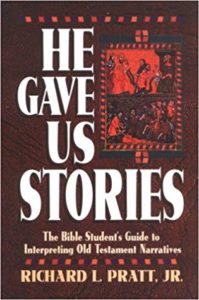He Gave Us Stories, by Richard Pratt
 We have a God who acts and speaks. He acts in history, and then he interprets his actions through his word. His word is full of stories.
We have a God who acts and speaks. He acts in history, and then he interprets his actions through his word. His word is full of stories.
To interpret those stories correctly, we need hermeneutics.
Hermeneutics is the study of principles or methods of interpretation. Whenever we read anything, either consciously or unconsciously we are using hermeneutics. We all have hermeneutics. The only question is whether they are good or bad.
Sometimes those biblical narratives can be hard to understand. Why did Moses write that story about Abraham cutting those animals in two in Genesis 15? Why did he spill so much ink on God’s tent in Exodus 25-31 and 35-40?
In He Gave Us Stories, Richard Pratt develops a model of hermeneutics to help us interpret biblical narratives.
He unpacks thematic, historical, and literary analysis. He works through characterization, scenes, and structures.
The heart of his model is getting to the original meaning by thinking through the author’s intent.
Think about it like this:
Writer ⇒ Document ⇒ Audience ⇒ Original Meaning
What is the author saying to the audience by shaping the narrative in this way?
In the case of Genesis, Moses was the author and his original audience was the second-generation Israelites on the plains of Moab about to enter the Promised Land. What is Moses saying by telling us that Abraham cut animals in half? He’s speaking of the covenant that God made to Abraham, a covenant that still stands for his original audience. Oh, and that tent in Exodus? That’s the tabernacle where the second-generation Israelites would have seen God’s presence represented by a pillar of fire by night and cloud by day.
Once you understand the original meaning, you have to think about how that applies to us today. To understand that correctly, you need to think about how Christ’s life, death, and resurrection—as interpreted through the New Testament—shapes the application of that meaning to us today.
In light of the cross (and some other things along the way, cf. Gen 22), we understand Abraham’s action of cutting animals in two to form a covenant to be pointing to Christ’s crucifixion. In light of the incarnation, we understand that tent to be foreshadowing Jesus coming and ‘tabernacling’ among us (cf. John 1:14).
When I was in seminary, He Gave Us Stories was one of the texts that Pratt had us use. We jokingly called it He Gave Us Homework. But I so appreciated the habits it set for me, I later assigned it as a text. It’s a lot of work, but it will improve your hermeneutics.
